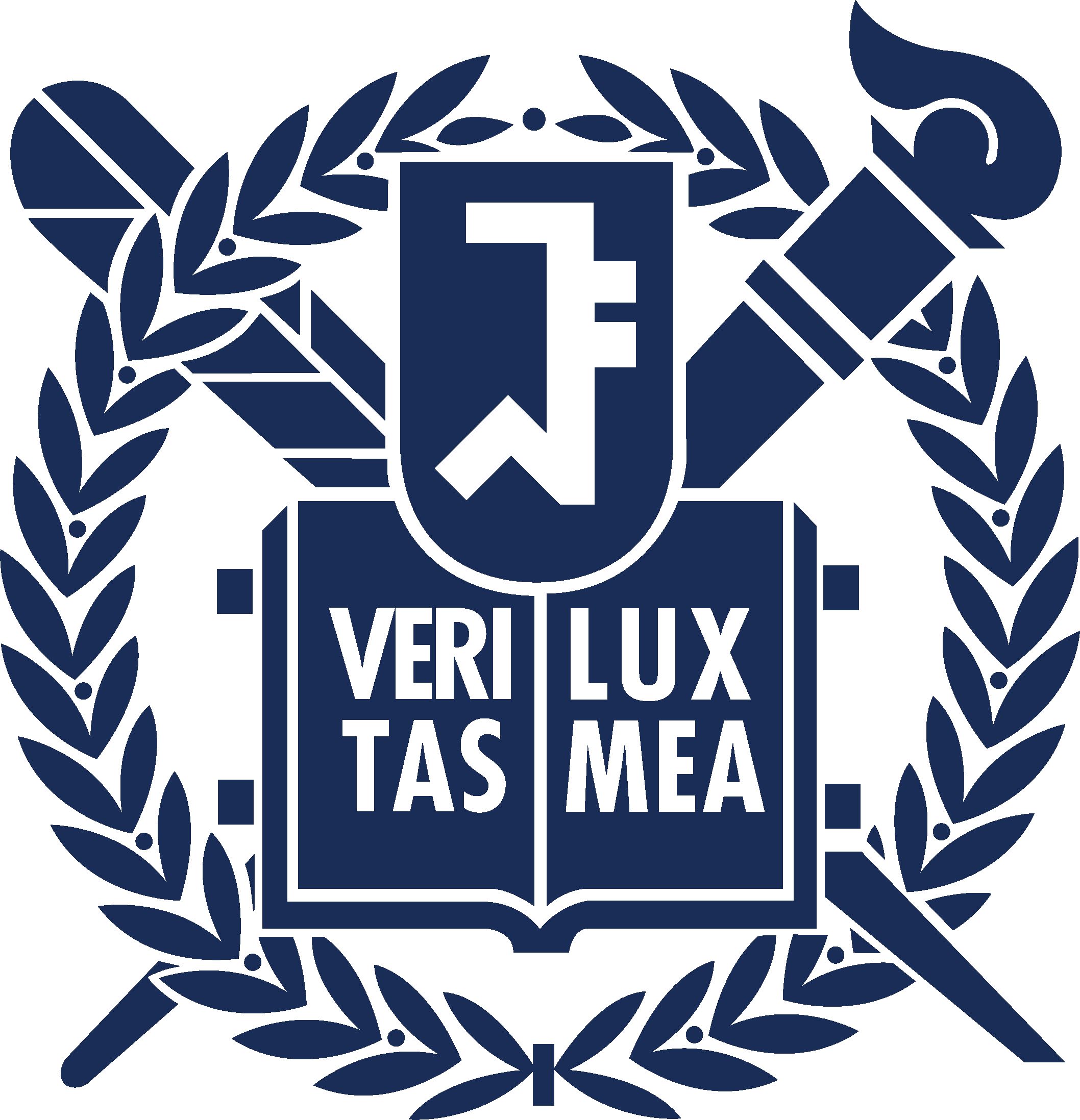RESEARCH
RESEARCH AREA
1
Tailor-made alloy design and process optimization of advanced engineering materials.
맞춤형 합금설계 및 공정 최적화
2
Process optimization for nano-structured material fabrication.
나노구조재료 제조공정 최적화 및 구조분석
3
Dynamic research on phase and property change.
상변태에 따른 특성 변화 분석
1. Tailor-made alloy design and process optimization of advanced engineering materials 맞춤형 합금설계 및 공정 최적화
1-1
Design of work hardenable bulk metallic glass composites with polymorphic transformed secondary phase In-situ
고인성 타이타늄계 구조재료 개발
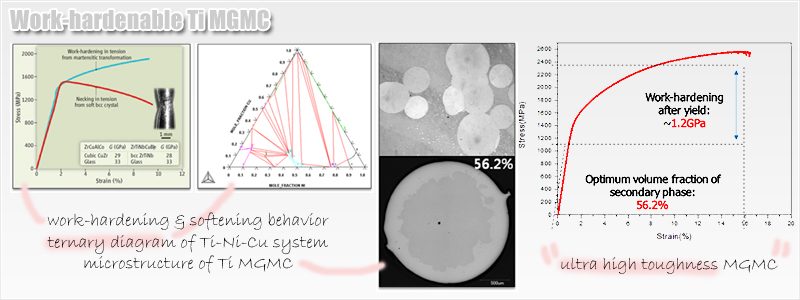
Bulk metallic glasses show many unique mechanical and physical properties such as high strength, relatively low Young’s modulus and perfect elastic behavior. However, monolithic BMGs undergo inhomogeneous plastic deformation under loading at room temperature, during which localized regions of shear bands are formed where the plastic flow is confined. This plastic flow allows only a few shear bands to be active and results in catastrophic failure. This instability severely restricts applications of BMGs. To solve this problem, the concept of developing composite microstructure with in-situ formed secondary phases has recently emerged. These BMG matrix composites (BMGMCs) exhibit enhanced compressive and tensile plasticity. However, because of the onset of localized deformation (early necking) with work softening behavior during deformation, there exists essential problem in development of BMGMC with high toughness. In the present study, we fabricated a novel Ti-based BMGMC that has an in-situ formed secondary phase precipitated by polymorphic transformation. And the relationship among mechanical properties, the morphology of the secondary phase and the phase transformation of secondary phase during deformation was systematically investigated. Especially, the effect of deformation-induced phase transformation of secondary phase on mechanical properties is identified by neutron diffraction measurement for the bulk samples. Our result indicates that a macroscopic work hardening behavior can be induced by phase transformation from the secondary phase precipitated by polymorphic transformation to stable crystalline phase during deformation, and that toughness can be enhanced significantly by designing the optimum morphology and fraction of in-situ formed secondary phase in Ti-based BMG matrix composites.
벌크 비정질 합금은 높은 강도와 상대적으로 낮은 영률(Young’s modulus)과 같은 우수한 기계적 특성을 갖지만, 유리천이온도 아래에서 변형률 없이 재료의 파괴가 나타나는 큰 한계점을 갖는다. 이를 개선하기 위하여 비정질 기지 내 응력유기변태가 가능한 제 2상을 첨가하여 인성을 크게 향상시키는 등의 새로운 복합소재 개발에 관한 연구를 진행 중이다. Transformation media를 제 2상으로 석출하여 기존의 벌크 비정질 복합재의 가공 연화를 극복하고 가공 경화 특성을 보이는 복합재를 타이타늄계 시스템에서 개발, 압축시험 결과 가공 경화 특성을 보이는 기존의 유일한 조성인 Cu-Zr-Al 복합재보다 더 높은 항복 강도와 우수한 연신을 나타내어 매우 우수한 인성을 가지는 복합재를 제조하는데 성공하였다. 이 타이타늄계 복합재는 고온/부식환경에서도 사용이 용이할 뿐 아니라 우수한 기계적 특성을 바탕으로 상용화에 유리할 것으로 보인다.
1-2
Development of high entropy alloys (HEAs)
신개념 하이엔트로피 합금 개발
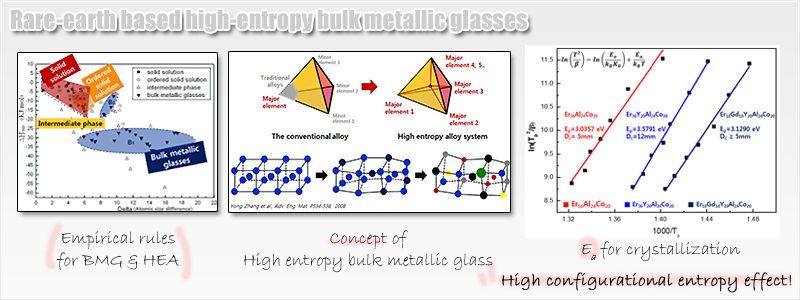
Conventional alloy systems are based on one principal element as a matrix and combined with other minor elements to improve their properties. Recently, new alloy systems called high entropy alloy (HEA) were developed. High entropy alloy contains multi-elements as major constituents, which leads to high mixing entropy and formation of simple solid solution rather than intermediate or intermetallic compound. Therefore, each constituent element could be regarded as a solute HEAs possibly have properties that are different from those of conventional alloys. With high entropy, HEA forms stable phase even at an elevated temperature and has excellent thermal stability. A general understanding of high entropy alloy enables design of new conceptual tailor made alloys systems focusing on specific applications by addition of various elements. Recently, it is reported that Pd-Pt-Cu-Ni-P BMGs with similar atomic percent called high entropy bulk metallic glass (HE-BMG) have high glass-forming ability as well as reduced glass transition temperature normalized with liquidus temperature. The present study focuses on development of HE-BMG based heavy rare earth (RE) and 4th transition metals, measures curie temperature of these systems, and shows that their properties are different from those of conventional systems. Unlike light RE elements, heavy rare earth elements have higher elastic modulus, and consequently heavy rare based bulk metallic glass (BMG) has higher glass forming ability (GFA). Especially, Nd, Gd, and Dy have a relatively low curie temperature, but Fe, Co, and Ni in the 4th transition elements have ferromagnetic property and high curie temperature. By mixing these two different groups, a novel magnetic HE-BMG could be fabricated and its magnetic properties are shown to exhibit unique behavior with alloy composition as well as temperature variation.
최근에 새롭게 개발된 하이엔트로피 합금은 여러 구성원소가 용질 원소로서 작용하여 고용체를 형성하며 이로 인해 재료 내에 높은 혼합 엔트로피 효과가 유발되고 고온에서도 안정한 상을 형성하며 우수한 열적 안정성을 갖는다. 이러한 하이엔트로피 합금 설계법을 비정질 합금 개발에 적용하여 무질서한 구조를 갖는 비정질 합금에서 혼합 엔트로피 효과를 극대화 하고자 한다.
1-3
In-situ synthesis of light-weight metal based composites In-situ
경량 금속 기지 복합재 개발
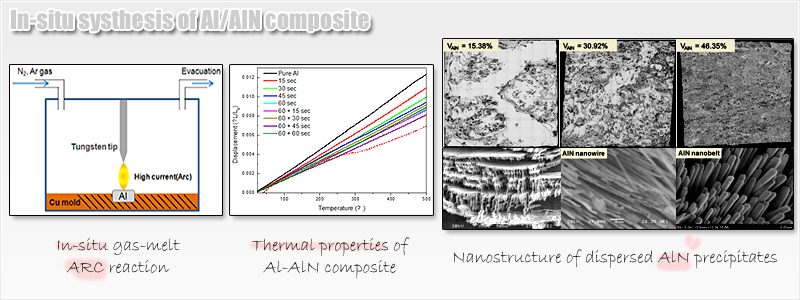
Thermal considerations in the electronic package design have become critically important because electronic devices generate more heat as the output power of electronic devices gets greater. For this reason effective transfer of heat by conduction requires materials of high thermal conductivity such as a heat sink material. To meet the demands for a high performance material for heat spreader materials, a composite composed of aluminum and aluminum nitride (AlN) was successfully manufactured under highly elevated temperature conditions. In-situ aluminum matrix composite reinforced with AlN was synthesized by gas-melt reaction at highly elevated temperature. Microstructure characterization showed that AlN reinforcements homogeneously distributed in the matrix, which exhibited clear interfaces between reinforcements, and matrix and size of the reinforcements was measured to be in the range from nano, submicron to a few microns. Volume fraction of reinforcement and mechanical properties of the composite were increased with increasing nitrogen gas-aluminum melt reaction time. After rolling process, thermal conduction and thermal expansion behavior of the composite were investigated. Thermal conductivity (TC) was slightly reduced and coefficient of thermal expansion (CTE) was remarkably lowered as volume fraction of reinforcement increases. AlN reinforcement did not react or decompose in the aluminum matrix as temperature of the composite increases up to 773 K. Thus, the interfacial reactions and problems associated with poor interface, which deteriorate TC and CTE, did not exist in the Al/AlN composite. Therefore, the in-situ composites may be applicable as heat-sink material, due to the combination of acceptable TC and low CTE.
반도체 소자의 효율 증가를 위해 방열 재료로서 열전도도가 크고 가벼우며 높은 가격 경쟁령을 갖는 알루미늄이 부각되고 있다. 하지만 알루미늄의 큰 열팽창계수로 인해 고온 환경에서의 응용이 제한되므로 열역학적으로 자발반응인 알루미늄의 질화 반응을 이용하여 용탕 상태의 알루미늄과 질소 가스를 반응시켜 강화재 AlN을 in-situ로 기지 내에 형성시키는 복합재를 제조하고자 한다. 이 공정을 바탕으로 다양한 경량 금속 기지 – 세라믹 석출상 복합재의 제조가 가능하다.
2. Process optimization for nano-structured material fabrication 나노구조재료 제조공정 최적화 및 구조분석
2-1
Thermoplastic forming process and evaluation of formability for metallic glass
과냉각 액체 영역을 활용한 비정질 재료의 성형 및 평가인자 제안
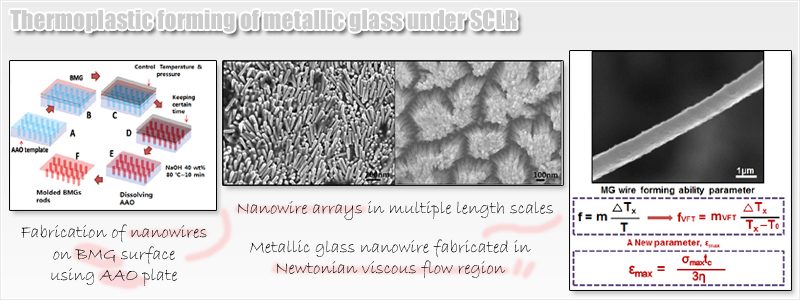
When bulk metallic materials are formed into microscale or nanoscale wires, they are attractive for engineering and functional applications, since they can be very useful in constructing small devices. While many materials are used for nanowires in a wide range of applications, they have some limitations such as ductility, vulnerability to corrosion, and delicate fabrication process. However, metallic glasses have many favorable properties compared to other materials, such as high strength and corrosion resistance, and as a result many researchers consider metallic glasses to have great potential. Furthermore, when a metallic glass is made into nanoscale size, in general, a shear band is not generated during the deformation, leading to greater ductility. In the present study, we propose a new parameter for evaluating formability of metallic glass wire in supercooled liquid region. In the supercooled liquid region, metallic glasses deformed in a homogeneous or inhomogeneous manner depending on strain rate. And a homogeneous deformation also can be classified into two viscous flow regions; Newtonian viscous flow region and non Newtonian viscous flow region. When metallic glass is deformed by non Newtonian viscous flow, various structural instabilities, such as nanocrystallization, occur, which may disturb the formation of thin metallic glass wire with uniform thickness. Thus, in the present study we focus on Newtonian viscosity flow of metallic glasses in supercooled liquid region. A parameter is proposed by considering maximum elongation of metallic glass during Newtonian viscous flow. The parameter contains Newtonian viscosity, crystallization temperature, and maximum stress of Newtonian viscous flow region and exhibits solid correlation with wire forming ability in metallic glasses. This criterion can give some idea about how we can fabricate metallic glass micro or nanowire while minimizing experimental efforts.
비정질 재료의 과냉각 액체 영역은 금속 비정질 소재의 plastic과 유사한 성형성을 부여한다. 이러한 특성을 활용한 실험 일례로, 기존의 Pt/C 전극에서 Pt의 함량을 획기적으로 줄인 Pt-Pd계 비정질 합금을 개발하여 비정질 합금의 과냉각 액체 영역에서 가공을 통해 합금 표면에 나노와이어 array를 제조함으로써 반응성과 표면적을 극대화한 새로운 촉매소재를 개발하고 DMFC 촉매로서의 활용 가능성을 평가하고자 한다. 또한, 비정질 재료가 나노 크기로 제조될 경우 변형이 일어나는 동안 전단띠가 나타나지 않으므로 큰 연성 특성을 가지게 된다. 과냉각 액체 영역에서의 변형 거동은 균일 변형 거동(newtonian viscous flow)과 불균일 변형 거동(non-newtonian viscous flow)으로 나눌 수 있는데, 불균일 변형 거동에 의해 비정질 합금이 변형될 때는 나노결정화와 같은 다양한 구조적 불안정성이 나타나며 이로 인해 균일한 두께를 갖는 비정질 나노 와이어가 형성되기 어렵다. 따라서 과냉각 액체 영역에서 균일 변형 거동이 일어나는 실험적 조건을 찾는 것이 중요하며 그 동안 비정질 합금의 최대 연신율을 결정하는 금속 비정질 나노 와이어의 형성평가 인자를 제안하고자 한다.
2-2
Synthesis of metallic glass nano powder by dealloying of phase separating metallic glasses
구조 맞춤형 재료: 상분리 비정질 합금
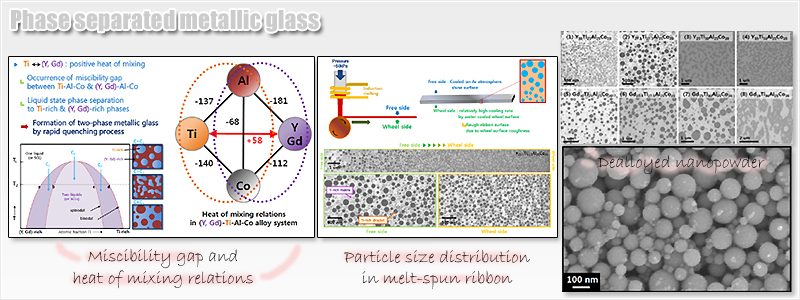
Generally, gas atomization method has been widely used for synthesizing metallic glass powder. However, this method is not appropriate for synthesizing metallic glass nano-powder since the minimum powder that can be fabricated by gas atomization is over tens of micrometer. On the other hand, chemical alloying process has been applied for synthesis of metallic glass nano-powder, but this ‘bottom-up’ method can be applied only to a limited set of alloying elements and the products of this method show uneven surface morphology. In order to solve this problem, the present study proposes a dealloying technique in phase separating metallic glasses as a novel ‘top-down’ process for synthesizing metallic glass nano-powder. In our experiments, (Ti, Zr)-based metallic glass nano-powder has been fabricated by the dealloying technique with Y-(Ti, Zr)-Al-Co phase separating metallic glasses. The droplet structure of each of the two-phase alloys has been investigated by electron microscopy, and Y-rich phase in two-phase alloys has been selectively dissolved by chemical process. The shape of the remaining phase was clearly spherical and perfectly matches the microstructure of the original two-phase alloys. The sizes of the fabricated powder were around tens of nanometer. The morphology and size of the synthesized nano-powder are significantly affected by the initial structure of the original two-phase alloys. Thus, the process control in synthesis of original two-phase alloy can be considered as a key factor for manipulating the sizes of fabricated nano-powder.
Gas atomization 법은 비정질 파우더를 제조하는 데 널리 사용되지만 이를 통해 제조되는 파우더는 마이크로 크기이므로 나노 크기의 금속 비정질 나노 파우더를 제조하는 데 적합하지 않다. 또한 화학적으로 합금화하여 금속 비정질 나노 파우더를 제조하는 경우 불균일한 표면 형상을 보이고 합금 조성이 제한된다는 한계점이 있다. 하지만 droplet 형태의 제 2상을 갖는 상분리 비정질 합금을 이용하여 각각의 상을 선택적으로 탈성분 부식을 시킴으로써 비정질 나노 파우더를 제조하여 초기 상의 형상과 크기 그대로 구현하고자 한다.
2-3
Three-dimensional microstructure characterization
3차원 미세구조 분석
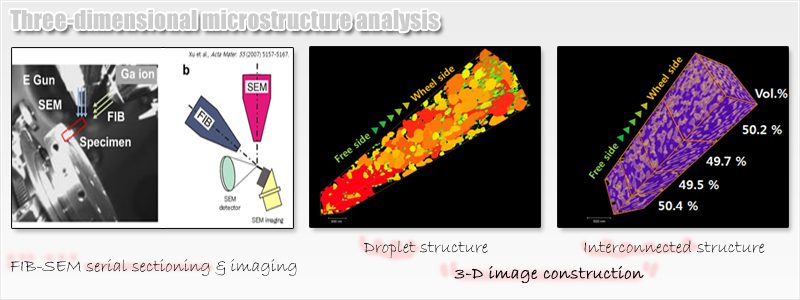
3-D materials science involves understanding physical and mechanical behaviors of materials through the characterization, modeling and utilization of 3-D microstructure and 3-D datasets. In traditional 2-D observation, the limited relations between 2-D and 3-D data were used for calculating the average size or size distribution depending upon characteristics of morphology, and this process typically results in error in calculated results. From 3-D microstructure, however, more precise grain/phase/defect stereology data can be obtained compared to 2-D observation. Obtained 3-D microstructure can be converted to 3-D mesh data which can be used as a basis of finite element method (FEM) modeling. It is well known that applications of bulk metallic glasses (BMGs) for structural materials are limited by their brittleness in spite of desirable mechanical properties such as high yield strength, high elastic limit, and relatively low elastic modulus. To overcome these drawbacks, various composite microstructures with structural heterogeneity of micrometer to nanometer scale in the amorphous matrix have been developed. The amorphous heterogeneities were expected to induce the nucleation of multiple shear bands and interruption of their propagation, which can lead to enhanced plasticity. However, nano-scale phase separated metallic glasses generally show extreme brittleness which is at odds with the expectations. In this study, we constructed 3-D microstructure of (Y, Gd)- Ti-Al-Co phase separating metallic glass by serial sectioning & imaging method using dual-beam FIB/SEM equipment. Two kinds of 3-D microstructure, droplet and interconnected phase separated structure, were obtained from aligning and stacking hundreds of 2-D SEM images and phase size distributions were calculated from 3-D images. Mechanical behaviors of these alloys were also investigated by FEM modeling based on 3-D mesh datasets. These results can help clarify the impact of secondary amorphous phase on mechanical properties of metallic glass matrix composites.
FIB와 SEM을 이용한 serial sectioning과 imaging 기법을 이용하여 3차원 분석을 수행함으로써 2차원 분석과 실제 물성값의 불일치를 해소할 수 있으며 결과적으로 상분리 비정질 합금에서 상의 크기 및 형태와 상분율을 정확하게 파악하여 금속 비정질 복합재의 기계적 특성에 대한 비정질 제 2상 효과를 규명하고자 한다.
3. Dynamic research on phase and property change 상변태에 따른 특성 변화 분석
3-1
Correlation between GFA and thermophysical properties measured by ESL
정전기 부양장치를 이용한 고온 열물성 및 비정질 형성능 측정
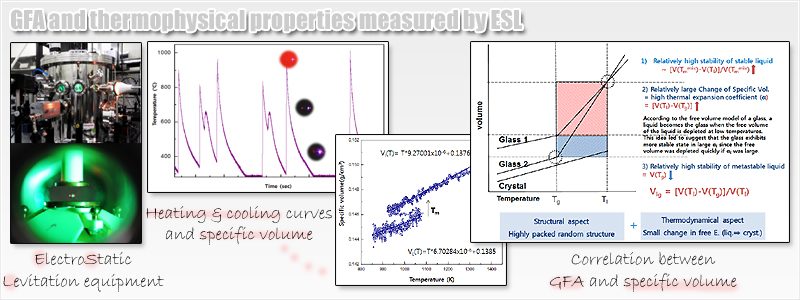
Generally, liquid phases transform to ordered crystalline phases below their melting temperature. The stability of undercooled liquids against crystallization is affected by initial viscosity of the liquids, increasing rate of viscosity due to temperature drop, free energy gap between undercooled liquids and crystalline phases, liquid/solid interface energy, bulk density, non-uniform nucleation, cooling rate of particle and so many other factors. As the undercooling of the molten alloys increases, the driving force of nucleation increases but the mobility of the atoms is rapidly degraded, with the consequence that nuclei generation is hampered. Eventually, the cooling rate is fast enough that diffusion among the atoms is limited, so the amorphous phase is uniformly solidified. This behavior is called glass transition behavior, and several metallic alloys with such behavior have been discovered, which can be cast in bulk amorphous form with low cooling rates. Thus, it is easy to obtain a wide undercooled liquid region in glass-forming alloy systems relative to typical crystalline materials, and the thermophysical properties in that undercooled liquid region play an important role in determining properties of amorphous phase after solidification. In this study, we measured the thermophysical properties of various bulk metallic glass-forming liquids of which compositional ranges are binary, ternary and quaternary eutectic alloys with different maximum diameters for glass formation, using a containerless high-temperature/high-vacuum electrostatic levitation technique. In addition, we carefully analyzed the microstructure of the alloy specimens collected after cooling using XRD and electron microscopes, which allows us to examine the undercooled liquid stability and phase transformation according to alloy composition. Thus, thermophysical properties of glass-forming alloys can be interpreted as parameters which help evaluate glass-forming ability as well as assist in discovering a new metallic glass forming system with high glass-forming ability.
정전기 부양장치는 전기장을 이용하여 물체를 공중에 띄워 레이저로 고온으로 가열시킴으로써 접촉에 의한 오염을 원천적으로 제거하여 물질의 고유한 물성 측정할 수 있으며 동시에 신물질 및 초고순도의 물질을 제조할 수 있는 기술이며 이를 통해 재료의 TTT diagram, 부피-온도 그래프와 온도에 따른 점도의 변화를 분석할 수 있다. 결과적으로 ESL을 통해 재료의 고온 열물성을 측정하는 것이 가능하며, 특히 비정질 합금의 비정질 형성능(GFA)과의 수치를 비교하여 과냉각 액체에 대한 효과 및 액상의 밀도와 비정질 형성능의 관련성을 확인하고 온도에 따른 점도의 변화를 통해 Vogel-Fulcher-Tammann 식 혹은 Arrhenius 관계를 통해 hysteresis 효과를 분석하고자 한다.
3-2
Correlation between phase transformation and property changes
상변태 거동과 특성 변화 간 상관 관계 규명
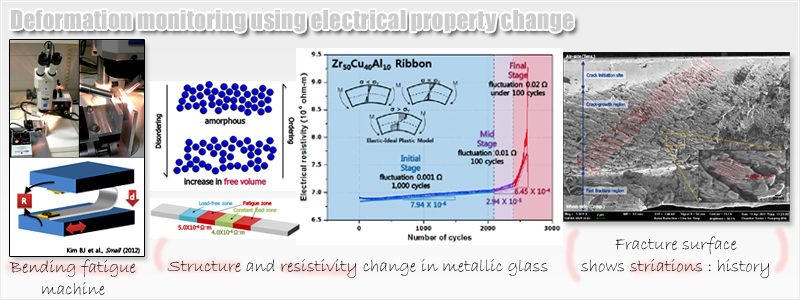
Shear band is the unit of the plastic deformation in metallic glasses, and causes changes in structure and properties of the glassy materials. It is significant to clarify the property and structural change of a metallic glass during plastic deformation. Therefore, the individual and collective behavior of shear bands should be properly investigated. Many researchers have intensively studied to determine the deformation mechanism of the metallic glasses. However, our understanding of how a shear deformed area affects glassy material’s properties as well as how a shear band initiates and propagates during deformation is still limited. In the current study, we discovered that electrical resistance changes as the number of shear bands increased with the bending of the specimen. This concept was used in bending fatigue test of metallic glass ribbon to evaluate nucleation and propagation of the shear bands – the amount of plastic deformation of metallic glass – in terms of electrical resistance. As a result, we detected variation of electrical resistance in real-time as the bending fatigue progressed. Eventually, we expect to evaluate a correlation between internal structure change such as shear band density and resistance change, which might be used as an indicator of the degree of plastic deformation in metallic glasses. Furthermore, we will carefully discuss the size effect by comparing fatigue behavior between bulk samples and ribbons of metallic glasses. This outcome helps explain the interrelationship between the microscale samples and macroscale samples as well as some additional influences of sample size on deformation. These results provide better understanding of dynamic behaviors of shear bands during deformation and the significance of shear deformed areas in determination of key characteristics of metallic glasses.
탄성 영역의 응력 조건에서 발현되는 점탄성 변형은 비정질 합금 내부의 free volume 및 원자들의 분포에 약간의 변화를 주어 기계적 특성의 변화가 나타날 수 있음이 보고된 바 있다. 본 연구에서는 이러한 점탄성 변형 거동을 유발할 수 있는 굽힘 피로 시험을 통하여 비정질 합금 시편의 특정 영역에 free volume의 확장을 일으켜 나타나는 전기적 특성의 변화를 관찰하였다. Free volume의 분율이 상대적으로 높은 전단띠 및 전단면이 비정질 기지에 형성됨에 따라 재료의 저항이 증가한다는 것을 실험적으로 확인하였다. 이러한 결과는 비정질 합금의 저항 변화 모니터링을 통하여 비정질 합금의 변형 정도(재료 내부의 free volume 분포 및 밀도)를 측정할 수 있는 가능성을 보여준다. 또한, 다양한 응력 조건에서의 점탄성 변형 거동 및 전단띠 거동에 관한 체계적인 고찰을 통하여 비정질 합금의 변형 기구에 관한 이해의 폭을 넓힐 수 있을 것으로 사료된다.
KEYWORDS
